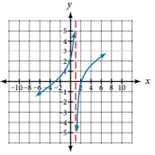xxMsJojoxx
Junior Member
- Joined
- Oct 6, 2020
- Messages
- 54
How do I find the equation for this rational function?

I know the x intercept is at 2 and -3, so that should make the numerator (x-2)(+3).
Also, the vertical asymptote is 1, so maybe the denominator is (x-1)
So that would make the equation
But the answer is , so I"m not sure how to interpret 1/3 coefficient and the 3x-1 denominator part from the graph.
, so I"m not sure how to interpret 1/3 coefficient and the 3x-1 denominator part from the graph.

I know the x intercept is at 2 and -3, so that should make the numerator (x-2)(+3).
Also, the vertical asymptote is 1, so maybe the denominator is (x-1)
So that would make the equation
But the answer is
Last edited:
